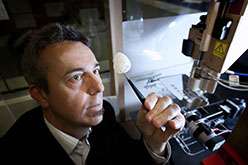A team from the Queensland University of Technology (QUT) in Brisbane has developed a way to make robust bioprints.
The problem facing bioprinting today is that the hydrogels used to print lattices upon which the living cells are deposited are very fragile. This makes them less useful for various practical applications where a sturdy structure may be required.
The new approach is the infuse the hydrogel with fibrous material, in a manner quite similar to how our own bodies reinforce soft tissue material. Apparently this approach increased the stiffness of the print by some 54x.
Structural robustness is one of many challenges facing the world of bioprinting. Another would be an ability to print thick objects, where nutrients are able to penetrate deeply to reach all the living cells.
It’s because of limitations like this that current commercial bioprinting operations have very limited product lines. Organovo, for example, makes a living by producing small tissue samples for laboratory testing. This is a great distance from being able to print whole human organs, for example.
However, the QUT team seems to have overcome one of the many obstacles to bioprinting progress.
Via Phys Org


